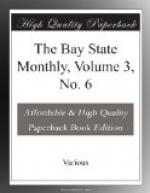They have a Wallace G.A.R. Post in Amesbury, not in commemoration of the Wallace of old Scottish fame, but of a man no less patriotic and brave who lived among themselves, an Englishman, a shoemaker. He was lame, but so anxious during the Rebellion to have his share in the struggle for the Union that he tried to get a place on board a gunboat, saying that he could “sit and shoot.” As this was impossible, the town sent him to Boston as its representative, and he was in the Legislature when the members voted themselves an increase of pay. Mr. Wallace believed the thing illegal. He took the money in trust. One day after his return to Amesbury he limped up to his physician (the same one who had brought about the better construction of the new corporation houses) and handed him fifty dollars of this over pay, to be used at his discretion among the poor, explaining as he did so where the money came from, that he felt that it belonged to Amesbury, and that he returned a part through this channel.
Half way between the Mills and the Ferry stands an old well that a native of Amesbury dug by the roadside for the benefit of travellers because he had once been a captive in Arabian deserts, and had known the torments of thirst. Here was a man to whom the uses of adversity had been sweet, for they had taught him humanity. Mrs. Spofford has written an appropriate poem upon this incident.
The elms in Amesbury are very beautiful, and they are found everywhere; but on the ferry road there are magnificent ones not far from the river. They are growing on each side of the road, arching it over with their graceful boughs.
[Illustration: WHITTIER’S HOME, AMESBURY.]
The Ferry proper near which was born Josiah Bartlett, one of the signers of the Declaration of Independence, is at the foot of the street that runs from the Mills down to the river. In old times there was a veritable ferry here a few rods above where the Powow empties into the Merrimack. This ferry is mentioned in the records, two years after the town had been set upon its feet. In a book written about Amesbury by Mr. Joseph Merrill, a native of the town, it is stated that the town petitioned the general Court for leave to keep a Ferry over the river at this place. This is the record from the same source:—




